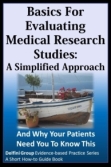 Click™
Click™ 

A Cool Click for Evidence-based Medicine (EBM) and Evidence-based Practice (EBP) Commentaries & Health Care Quality Improvement Nibblets
The EBM Information Quest: Is it true? Is it useful? Is it usable?™
Valdity Detectives: Michael E Stuart MD, President & Medical Director . Sheri Ann Strite, Managing Director & Principal

Why Critical Appraisal Matters
DelfiniClick™Evidence & Quality Improvement Commentaries |
Follow & Share...
DelfiniGram™: GET ON OUR UPDATE LIST ![]()
Volume
— Quality
of Evidence: Newest
|
|
Reliable Clinical Guidelines—Great Idea, Not-Such-A-Great Reality Although clinical guideline recommendations about managing a given condition may differ, guidelines are, in general, considered to be important sources for individual clinical decision-making, protocol development, order sets, performance measures and insurance coverage. The Institute of Medicine [IOM] has created important recommendations that guideline developers should pay attention to—
Investigators recently evaluated 114 randomly chosen guidelines against a selection from the IOM standards and found poor adherence [Kung 12]. The group found that the overall median number of IOM standards satisfied was only 8 out of 18 (44.4%) of those standards. They also found that subspecialty societies tended to satisfy fewer IOM methodological standards. This study shows that there has been no change in guideline quality over the past decade and a half when an earlier study found similar results [Shaneyfeld 99]. This finding, of course, is likely to have the effect of leaving end-users uncertain as to how to best incorporate clinical guidelines into clinical practice and care improvements. Further, Kung’s study found that few guidelines groups included information scientists (individuals skilled in critical appraisal of the evidence to determine the reliability of the results) and even fewer included patients or patient representatives. An editorialist suggests that currently there are 5 things we need [Ransohoff]. We need: 1. An agreed-upon transparent, trustworthy process for developing ways to evaluate clinical guidelines and their recommendations. 2. A reliable method to express the degree of adherence to each IOM or other agreed-upon standard and a method for creating a composite measure of adherence. From these two steps, we must create a “total trustworthiness score” which reflects adherence to all standards. 3. To accept that our current processes of developing trustworthy measures is a work in progress. Therefore, stakeholders must actively participate in accomplishing these 5 tasks. 4. To identify an institutional home that can sustain the process of developing measures of trustworthiness. 5. To develop a marketplace for trustworthy guidelines. Ratings should be displayed alongside each recommendation. At this time, we have to agree with Shaneyfeld who wrote an accompanying commentary to Kung’s study [Shaneyfeld 12]:
References 1. IOM: Graham R, Mancher M, Wolman DM, et al; Committee on Standards for Developing Trustworthy Clinical Practice Guidelines; Board on Health Care Services. Clinical Practice Guidelines We Can Trust. Washington, DC: National Academies Press; 2011 http://www.nap.edu/catalog.php?record_id=13058 2. Kung J, Miller RR, Mackowiak PA. Failure of Clinical Practice Guidelines to Meet Institute of Medicine Standards: Two More Decades of Little, If Any, Progress. Arch Intern Med. 2012 Oct 22:1-6. doi: 10.1001/2013.jamainternmed.56. [Epub ahead of print] PubMed PMID: 23089902. 3. Ransohoff DF, Pignone M, Sox HC. How to decide whether a clinical practice guideline is trustworthy. JAMA. 2013 Jan 9;309(2):139-40. doi: 10.1001/jama.2012.156703. PubMed PMID: 23299601. 4. Shaneyfelt TM, Mayo-Smith MF, Rothwangl J. Are guidelines following guidelines? The methodological quality of clinical practice guidelines in the peer-reviewed medical literature. JAMA. 1999 May 26;281(20):1900-5. PubMed PMID: 10349893. 5. Shaneyfelt T. In Guidelines We Cannot Trust: Comment on "Failure of Clinical Practice Guidelines to Meet Institute of Medicine Standards". Arch Intern Med. 2012 Oct 22:1-2. doi: 10.1001/2013.jamainternmed.335. [Epub ahead of print] PubMed PMID: 23089851.
|
|
| Quality
of Clinical Guidelines
Clinical guidelines can improve care and conserve resources, but they vary greatly in quality. Several groups (including Delfini) have created tools to evaluate someone else’s guidelines. A key component of guideline evaluation is the process by which the guideline was developed. In a recent issue of the Journal of Clinical Epidemiology, Giannakakis et al report that although the use of RCTs in developing clinical guidelines has increased, almost half of the guidelines appearing in journals such as the Annals of Internal Medicine, BMJ, JAMA, NEJM, Lancet and Pediatrics do not cite RCTs! Because observational studies and expert opinion are usually insufficient to draw conclusions about effectiveness (cause/effect relationship between intervention and outcomes), any prevention or treatment guidelines not based on RCTs may have major problems with validity. To read the abstract of this article, go to — J Clin Epidemiol
2002 Jun;55(6):545-55
|
|
Clinical Guidelines and Elderly Patients—Proceed with Caution We were alerted to this important study of clinical practice guidelines (CPGs) in elderly patients with co-morbidities [1] by Demetra Antimisiaris, an associate professor who directs the polypharmacy initiative at the University of Louisville School of Medicine.
|
|
Poor Quality of Guidelines: Case Study — The Evidence on Well-Child Care Recommendations An article in the December 2004 issue of PEDIATRICS illustrates a common problem in health care—the gap between expert’s opinions and recommendations and quality scientific medical evidence. Moyer and Butler reviewed recommendations for well-child care made by seven major North American organizations and compared them to the best available evidence (systematic reviews of randomized controlled trials and individual randomized controlled trials). Results Some of the key points made by the authors are --
Comments Moyer VA and Butler M. Gaps in the Evidence for Well-Child Care: A Challenge to Our Profession. PEDIATRICS;114 No. 6 : 1511-1521. PMID: 15574609
|
|
Another
Cautionary Tale About Clinical Guidelines: Screening for Heart
Attack Prevention and Education (SHAPE) Task Force Guidelines
Example The Screening for Heart Attack Prevention and Education (SHAPE) Task Force guidelines[1] are clinical recommendations developed through a consensus process by a group of health care professionals and others. The lead author of the SHAPE guidelines is the CEO and President of Endothelix. Endothilix is medical device company “dedicated to human vascular health, with particular emphasis on screening for and monitoring vascular endothelial dysfunction.”[2] There are several unique features of these guidelines. They go far beyond any other cardiovascular risk screening guidelines and “call for” the following:
The authors recommend careful and responsible implementation of these tests as part of a comprehensive risk assessment and reduction approach. They do not, however, provide any evidence of improved outcomes for patients undergoing these tests and state that cost-effectiveness of the use of these tests in a comprehensive strategy must be validated. In his commentary on the SHAPE Task Force guidelines in the January 9, 2008 issue of the Journal of the American Medical Association (JAMA)[3], Peter Jacobson points out that SHAPE’s recommendations are bad public policy, in part, because they lack evidence for improved outcomes and the possibility of harms outweighing benefits. Jacobson suggests that guidelines be “vetted” by professional societies as a way of establishing validity and clinical usefulness. At first blush this sounds reasonable. But unfortunately this will not solve the problem of unproven clinical recommendations. We have seen numerous examples of guidelines published by professional societies which are based on weak or fatally flawed evidence such as in the areas of cholesterol screening in children, treatment of Bell’s Palsy and interventions for chronic spinal pain. Others have reported similar findings.[4] Grilli et al.[5], in a review of 431 guidelines produced by U.S. medical societies, found that —
We recommend that users of guidelines and other clinical recommendations scrutinize all such documents for validity and usefulness rather than relying on endorsement by professional societies, reliance upon which is reasonably likely to lead to outcomes as problematic as Jacobsen suggests. At a minimum, we suggest the pertinent questions are these:
Although peer-review may be desirable, we believe that the type of checklist above provides a more appropriate solution for the evaluation of clinical guidelines for validity and clinical usefulness than specialty society endorsement because it helps remove the bias which may be present in any group making clinical recommendations based on consensus and low quality evidence.[7] We also wholeheartedly agree that “guidelines” should not be mandated through legislation. In the case of the SHAPE recommendations, Texas House Representative Rene Oliveira plans to introduce in 2008 his bill into state legislature. The bill would mandate insurers to cover screening of asymptomatic atherosclerosis using calcium scanning and carotid ultrasound, as recommended in the SHAPE initiative. Let’s hope the Texas legislature is awake and alert.
|
|
Review of Endocrinology Guidelines Decision-makers frequently rely on the body of pertinent research in making decisions regarding clinical management decisions. The goal is to critically appraise and synthesize the evidence before making recommendations, developing protocols and making other decisions. Serious attention is paid to the validity of the primary studies to determine reliability before accepting them into the review. Brito and colleagues have described the rigor of systematic reviews (SRs) cited from 2006 until January 2012 in support of the clinical practice guidelines put forth by the Endocrine Society using the Assessment of Multiple Systematic Reviews (AMSTAR) tool [1]. The authors included 69 of 2817 studies. These 69 SRs had a mean AMSTAR score of 6.4 (standard deviation, 2.5) of a maximum score of 11, with scores improving over time. Thirty five percent of the included SRs were of low-quality (methodological AMSTAR score 1 or 2 of 5, and were cited in 24 different recommendations). These low quality SRs were the main evidentiary support for five recommendations, of which only one acknowledged the quality of SRs. The authors conclude that few recommendations in field of endocrinology are supported by reliable SRs and that the quality of the endocrinology SRs is suboptimal and is currently not being addressed by guideline developers. SRs should reliably represent the body of relevant evidence. The authors urge authors and journal editors to pay attention to bias and adequate reporting. Delfini note: Once again we see a review of guideline work which suggests using caution in accepting clinical recommendations without critical appraisal of the evidence and knowing the strength of the evidence supporting clinical recommendations. 1. Brito JP, Tsapas A, Griebeler ML, Wang Z, Prutsky GJ, Domecq JP, Murad MH, Montori VM. Systematic reviews supporting practice guideline recommendations lack protection against bias. J Clin Epidemiol. 2013 Jun;66(6):633-8. doi: 10.1016/j.jclinepi.2013.01.008. Epub 2013 Mar 16. PubMed PMID: 23510557.
|
........
At DelfiniClick™
Menu........
Use of our website implies agreement to our Notices. Citations for references available upon request.
Home
Best of Delfini
What's New
Blog
Seminars
Services
Delfini Group Publishing
Resources
Sample Projects
Notices
About
Us & Our Work
Testimonials
Other
Site Search
Contact
Info/Updates
........
Quick Navigator to Selected Resources
- Tools & Educational Library
- The Healthcare Information Problem
- Tutorials
- DelfiniClick™—commentaries
- On the Same Page™—patient decision support
- Evidence Messaging Scripts
- Delfini Publications
- Medical Leader Interviews
- Glossary
- Recommended Reading
- Recommended Web Links
- Delfini Critical Appraisal Flier
- Get DelfiniGram™ Updates
.......................






